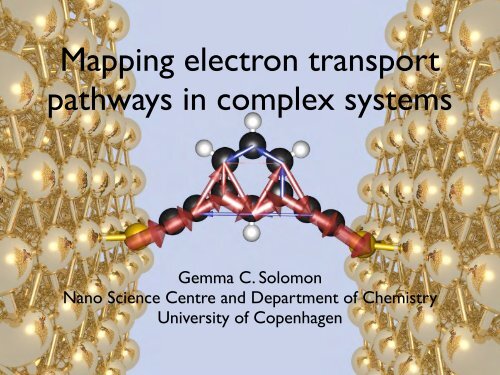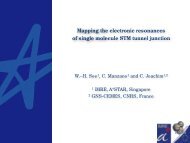Gemma C. Solomon Nano Science Centre and Department ... - AtMol
Gemma C. Solomon Nano Science Centre and Department ... - AtMol
Gemma C. Solomon Nano Science Centre and Department ... - AtMol
You also want an ePaper? Increase the reach of your titles
YUMPU automatically turns print PDFs into web optimized ePapers that Google loves.
Mapping electron transport<br />
pathways in complex systems<br />
<strong>Gemma</strong> C. <strong>Solomon</strong><br />
<strong>Nano</strong> <strong>Science</strong> <strong>Centre</strong> <strong>and</strong> <strong>Department</strong> of Chemistry<br />
University of Copenhagen
Local properties are central in our<br />
underst<strong>and</strong>ing of chemistry<br />
From Hammett constants, to Mulliken<br />
charges to local spins, local properties<br />
underpin structure-function relationships<br />
in chemistry.<br />
For new types of physical measurements,<br />
like passing current through a molecule,<br />
we need new local descriptions.<br />
If we can underst<strong>and</strong> how different<br />
components interact in a complex system,<br />
maybe we can design interesting devices<br />
L. P. Hammett JACS (1937) 59, 96
Questions:<br />
!"#$%!&#'()*+<br />
)%(,%-./!0<br />
How do different functional groups<br />
in a molecule modulate transport<br />
Do they always participate<br />
Does current through a molecule<br />
always follow the bonds<br />
When might through-space<br />
interactions be important Is<br />
overlap all that matters<br />
Can we map the characteristic<br />
transport pathways through a<br />
complex molecular system
Calculating conductance<br />
<br />
α β<br />
<br />
E = α − β<br />
H =<br />
β α<br />
E = α + β<br />
Γ L =<br />
<br />
2a 0<br />
0 0<br />
Γ R =<br />
<br />
0 0<br />
02a<br />
<br />
Σ = i(Γ L + Γ R )<br />
2<br />
H =H − Σ<br />
α − ia<br />
=<br />
β<br />
β<br />
α− ia<br />
<br />
G r =<br />
1<br />
ES− H <br />
G a = G r†<br />
T =Tr[Γ L G r Γ R G a ]
Calculating current from transmission<br />
I(V )= 2e<br />
h<br />
Z ∞<br />
−∞<br />
dETr[Γ L G r Γ R G a ]( f L − f R )
Nature Chem. 2,! 223-228 (2010)<br />
Current through an arbitrary surface<br />
I mn = 2e<br />
¯h<br />
Z dε<br />
2π K mn(ε)<br />
I = 2e<br />
h<br />
∑<br />
m∈M L<br />
Z<br />
∑<br />
n∈M R<br />
dεK mn (ε)<br />
∑<br />
m∈M L<br />
K mn (ε)=∑<br />
i∈m<br />
∑ K mn (ε)=(f L (ε) − f R (ε))T (ε)<br />
n∈M R<br />
∑ ∑(if L (V ij G r jkΓ L klG a li−V ji G r ilΓ L lkG a kj)<br />
j∈n kl<br />
n=m<br />
−if R (V ji G r ilΓ R lkG a kj−V ij G r jkΓ R klG a lj))
Conservation
What does local transmission look like<br />
A note about local transmission plots:<br />
The radius of the arrow is<br />
proportional to the magnitude of the<br />
local transmission<br />
The arrows are normalized so the<br />
largest component in each picture is<br />
the same size.<br />
The arrows are only shown for<br />
elements that are greater than 10%<br />
of the maximum local transmission<br />
element.<br />
The arrows are sometimes coloured<br />
red <strong>and</strong> blue to indicate transmission<br />
in the forward <strong>and</strong> reverse direction.<br />
Nature Chem. 2,! 223-228 (2010)
More involved local transmission<br />
Nature Chem. 2,! 223-228 (2010)
π transmission & Total transmission<br />
Nature Chem. 2,! 223-228 (2010)
Cross-conjugated molecules<br />
“a compound possessing three unsaturated groups,<br />
two of which although conjugated to a third<br />
unsaturated center are not conjugated to each other.”<br />
N. F. Phelan, M. Orchin, J. Chem. Educ. 45, 633 (1968)
Similar behavior<br />
Nature Chem. 2,! 223-228 (2010)
σ-systems can be unusual too<br />
ϕ=180 ϕ=0
We can see the signature of interference<br />
Nature Chem. 2,! 223-228 (2010)
Designing molecular electronic devices....<br />
....means assembling molecules<br />
Positioning single molecules between<br />
metallic electrodes is an enormous<br />
challenge.<br />
J. Heath <strong>and</strong> M. Ratner, Physics Today, May 2003<br />
Controllable synthesis of really large<br />
molecules is another enormous<br />
challenge.<br />
J. Heath<br />
Self-assembly of supramolecular<br />
structures or carefully constructed films<br />
seem to be a promising alternative.<br />
M. Reed <strong>and</strong> J. Tour Scientific American, June 2000
π-stacked structures are favorable<br />
for self-assembly<br />
Non-bonding interactions can be used<br />
to build extremely large structures.<br />
These structures have been suggested<br />
as architectures for charge transport.<br />
What is really desirable for charge<br />
transport in a π-stacked system<br />
J. A. A. W. Elemans, A. E. Rowan <strong>and</strong> R. J. M. Nolte<br />
J. Mater. Chem. (2003) 13 2661<br />
R. van Hameren et al.<br />
<strong>Science</strong> (2006) 314 1433
J. Am. Chem. Soc. 132,! 7887-7889 (2010)<br />
Take a simple series
Increasing transmission<br />
by reducing overlap<br />
J. Am. Chem. Soc. 132,! 7887-7889 (2010)
Perturbing interference features
Putting it all together: the super stacker<br />
!"#$%!&#'()*+<br />
)%(,%-./!0<br />
Hydrogen bonds<br />
stabilize the !-stacker<br />
short aliphatic chain<br />
forces alignment<br />
between aromatic units<br />
J. Am. Chem. Soc. 133,! 2242-2249 (2011)<br />
Alkene-thiols connect the<br />
stacker to the Au contacts
Pulling the super stacker<br />
Nonequilibrium<br />
trajectory<br />
Pulling speed ~<br />
10 -3 Å/ps<br />
k = 1.1 N/m<br />
J. Am. Chem. Soc. 133,! 2242-2249 (2011)
Mechanically activated molecular switch<br />
pulling speed ~ 10 -6 Å/ps<br />
k = 1.1 N/m<br />
unfolding<br />
“On”<br />
Drop of 3-4 orders of<br />
magnitude<br />
Note: the size of the fluctuations<br />
“Off”<br />
J. Am. Chem. Soc. 133,! 2242-2249 (2011)
Agreement between transport methods<br />
Huckel IV<br />
unstacked<br />
π-stacked<br />
gDFTB<br />
molecular end to end distance<br />
Methods agree in average, disagree for individual conformations
Bistability leads to<br />
blinking in the conductance<br />
ON<br />
OFF<br />
J. Am. Chem. Soc. 133,! 2242-2249 (2011)<br />
L=22.7Å
The cow diagram:<br />
underst<strong>and</strong>ing transport domains<br />
J. Am. Chem. Soc. 133,! 2242-2249 (2011)
Acknowledgements<br />
Anders Borges<br />
Justin Bergfield<br />
Mark Ratner<br />
David Andrews<br />
Carmen Herrman<br />
Thorsten Hansen<br />
Josh Vura-Weis<br />
R<strong>and</strong>all Goldsmith<br />
Ignacio Franco<br />
Christopher George<br />
Michael Wasielewski<br />
Richard Van Duyne<br />
Vladimiro Mujica<br />
George Schatz<br />
$$$<br />
DoE, NSF-Chemistry, NSF-<br />
MRSEC,ONR-Chemistry



